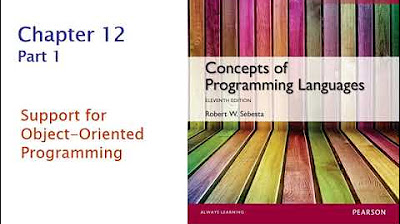COS 333: Chapter 5, Part 1
Summary
TLDRThis lecture delves into the core concepts of imperative programming languages, focusing on variables and their attributes like names, bindings, and scopes. It discusses the von Neumann architecture's influence on imperative languages and explores variable types, design issues in programming language creation, and the trade-offs between static and dynamic type bindings. The lecture also examines different variable lifetimes and their allocation from memory pools, highlighting the advantages and disadvantages of each, and concludes with a look at implicit heap dynamic variables in scripting languages.
Takeaways
- 📘 Imperative programming languages are abstractions of the von Neumann architecture, simulating memory, processor, and the pipeline between them.
- 🔑 Variables in imperative programming are central, acting as abstract representations of memory cells characterized by attributes like name, address, value, type, lifetime, and scope.
- 🔠 Names or identifiers are programmer-specified labels for variables and other program features, essential for referencing within a program.
- 🎨 Design issues in programming languages include decisions on valid forms for names, the use of special characters, case sensitivity, and the treatment of special words like keywords and reserved words.
- ⚖️ Trade-offs in language design involve balancing factors like readability, writability, and the potential for name collisions when deciding on name conventions and special words.
- 🔬 Variables have six attributes: name, address, value, type, lifetime, and scope, with the latter two being closely related and often discussed together.
- 🔄 Static and dynamic bindings differentiate based on when they occur: static bindings happen before runtime and remain unchanged, while dynamic bindings can occur during runtime or change post-runtime.
- 📚 Static type binding fixes a variable's type before runtime, using explicit or implicit declarations, while dynamic type binding allows a variable's type to change during execution, offering flexibility but at the cost of potential errors.
- 🗃️ Variable lifetime is tied to storage binding, with four types of variables identified by their lifetime: static, stack dynamic, explicit heap dynamic, and implicit heap dynamic variables.
- 🔄 Static local variables are allocated once before program execution and persist throughout, enabling history-sensitive sub-programs but limiting flexibility and storage reuse.
- 📈 Stack dynamic variables are allocated and deallocated on the call stack, offering advantages like support for recursion but introducing overhead due to allocation dynamics.
Q & A
What is the main focus of the lectures following the discussion on functional and logic programming languages?
-The main focus shifts back to imperative programming languages, starting with the concept of variables, which are central to imperative programming.
What are the two specific topics related to variables that will be discussed in the next two lectures?
-The two specific topics are names bindings and scopes as they relate to variables.
How does the von Neumann architecture relate to imperative programming languages?
-Imperative programming languages are abstractions of the von Neumann architecture, which consists of memory and a processor linked by a pipeline, simulating these components and their interactions in software.
What are the six attributes that characterize every variable in imperative programming languages?
-The six attributes are the variable's name, address, value, type, lifetime, and scope.
What is the significance of the term 'alias' in the context of variables?
-An alias refers to two variables with different names that refer to the same memory location, typically implemented through pointers, references, or unions.
What are the two main design issues a programming language designer needs to consider regarding names?
-The two main design issues are the form that names can take within a programming language and the treatment of special words, deciding whether they are reserved or keywords.
Why might a programming language designer choose to use special characters in variable names?
-Special characters can improve the readability of a programming language by quickly identifying variable names or their types, as seen in languages like PHP, Perl, and Ruby.
What is the difference between static binding and dynamic binding?
-Static binding occurs before runtime and remains unchanged, while dynamic binding either occurs during runtime or can change during program execution even after being set before runtime.
What are the advantages and disadvantages of using implicit declarations for variable types?
-Implicit declarations can improve writability by reducing the need for explicit type declarations, but they can also reduce reliability if programmers are unaware of the default mechanisms used for type determination.
How does the concept of variable lifetime relate to storage binding?
-Variable lifetime is the duration a variable is bound to a memory cell, and storage binding is the process of allocating and deallocating memory cells to and from variables, which directly affects the variable's lifetime.
What are the four kinds of variables identified based on their lifetimes?
-The four kinds of variables based on their lifetimes are static local variables, stack dynamic variables, explicit heap dynamic variables, and implicit heap dynamic variables.
Outlines

This section is available to paid users only. Please upgrade to access this part.
Upgrade NowMindmap

This section is available to paid users only. Please upgrade to access this part.
Upgrade NowKeywords

This section is available to paid users only. Please upgrade to access this part.
Upgrade NowHighlights

This section is available to paid users only. Please upgrade to access this part.
Upgrade NowTranscripts

This section is available to paid users only. Please upgrade to access this part.
Upgrade Now5.0 / 5 (0 votes)





